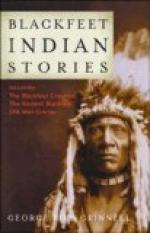In warm weather men and boys wore little clothing. They went almost naked; yet in cold weather each man or woman was most of the time wrapped in a warm robe of tanned buffalo skin. Even the little children wore robes, the smallest ones those taken from the little buffalo calves. All their clothing, like their beds and their homes, was made of the skins of animals. Shirts, women’s dresses, leggings, and moccasins were made from the tanned skins of buffalo, deer, antelope, and mountain sheep. Often the moccasins were made from the smoked skin cut from the top of an old lodge, for this skin had been smoked so much that it never dried hard and stiff, after it had been wet. The moccasins had a stiff sole of buffalo rawhide; and in the bottom of this sole were cut one or two holes, in order that the water might run out if a man had to wade through a stream.
The homes of these Indians were lodges—tents made of tanned buffalo skin supported on a cone of long, straight, slender poles. At the top where the poles crossed was an opening for the smoke from the fire built in the centre of the circular lodge floor, while about the fire, and close under the lodge covering, were the beds where the people slept or ate during the day.
These homes were warm and comfortable. The border of the lodge covering did not come down quite to the ground, but inside the lodge poles, and tied to them, was a long wide strip of tanned buffalo skin four or five feet high, and long enough to reach around the inside of the lodge, almost from one side of the door to the other. This strip of tanned skin—made up of several pieces—was so wide that one edge rested on the floor, and reached inward under the beds and seats. Through the open space between the lodge covering and the lodge lining, fresh air kept passing into the lodge close to the ground and up over the lining and down toward the centre of the lodge, and so furnished draught for the fire. The lodge lining kept this cold air from blowing directly on the occupants of the lodge who sat around the fire. Often the lodge lining was finely painted with pictures of animals, people, and figures of mysterious beings of which one might not speak.
The seats and beds in this home were covered with soft tanned buffalo robes, and at the head and foot of each bed was an inclined back-rest of straight willow twigs, strung together on long lines of sinew and supported in an inclined position by a tripod. Buffalo robes often hung over these back-rests. In the spaces between the back-rests, which though they came together at the top were separated at the ground, were kept many of the possessions of the family; the pipe, sacks of tobacco, of paint, “possible sacks”—parfleches for clothing or food, and many smaller articles.




